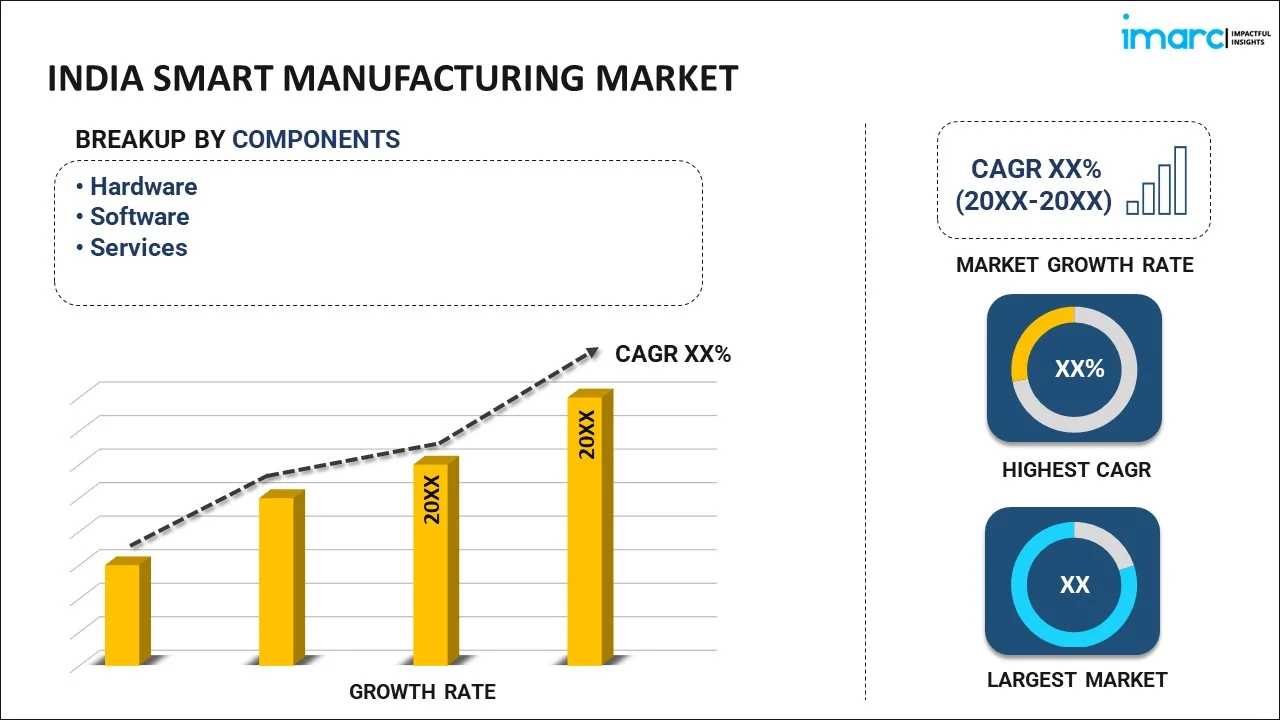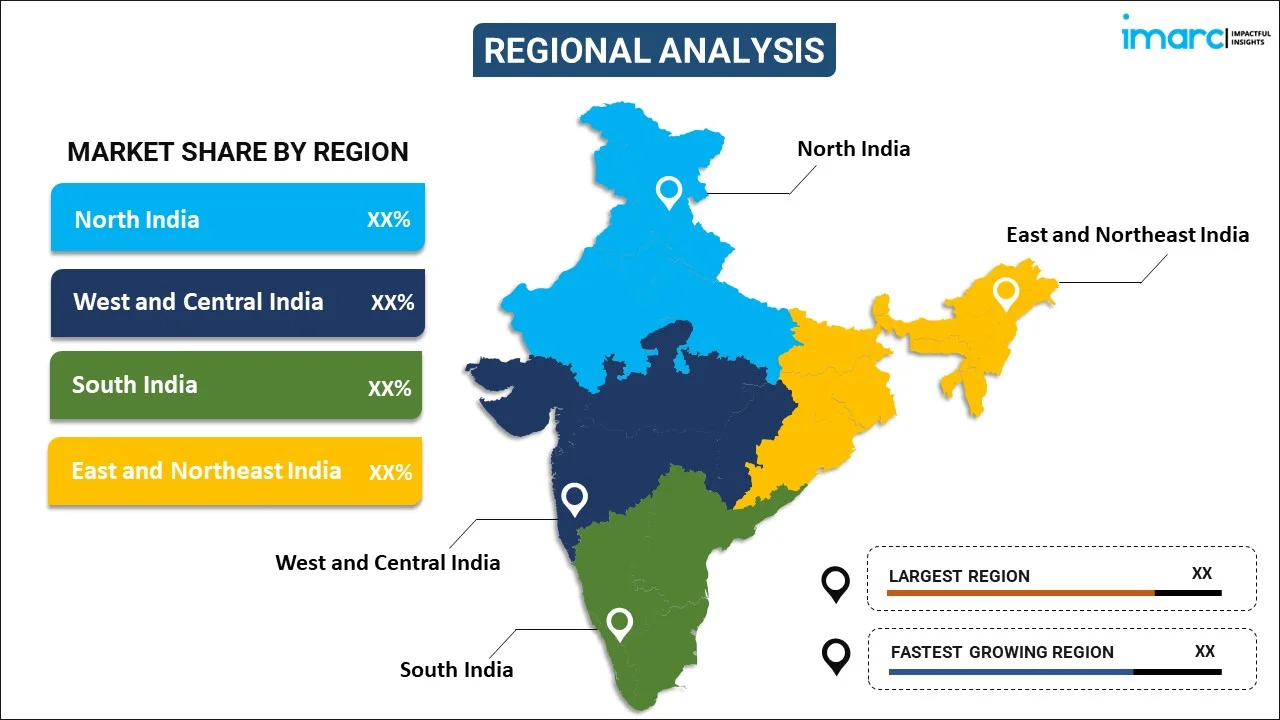
India Smart Manufacturing Market Report by Component (Hardware, Software, Services), Technology (Machine Execution Systems, Programmable Logic Controller, Enterprise Resource Planning, SCADA, Discrete Control Systems, Human Machine Interface, Machine Vision, 3D Printing, Product Lifecycle Management, Plant Asset Management), End Use (Automotive, Aerospace and Defense, Chemicals and Materials, Healthcare, Industrial Equipment, Electronics, Food and Agriculture, Oil and Gas, and Others), and Region 2025-2033
Market Overview:
India smart manufacturing market size reached USD 12.5 Billion in 2024. Looking forward, IMARC Group expects the market to reach USD 20.5 Billion by 2033, exhibiting a growth rate (CAGR) of 5.1% during 2025-2033. The integration of smart devices and systems, which creates a more collaborative and interconnected manufacturing environment, fostering improved communication and coordination, is driving the market.
|
Report Attribute
|
Key Statistics
|
|---|---|
|
Base Year
|
2024
|
|
Forecast Years
|
2025-2033
|
|
Historical Years
|
2019-2024
|
|
Market Size in 2024
|
USD 12.5 Billion |
|
Market Forecast in 2033
|
USD 20.5 Billion |
| Market Growth Rate 2025-2033 | 5.1% |
Smart manufacturing refers to the integration of advanced technologies and digital intelligence into the manufacturing process to enhance efficiency, productivity, and adaptability. It involves the use of technologies such as the Internet of Things (IoT), artificial intelligence (AI), big data analytics, and automation to create a connected and intelligent manufacturing ecosystem. Smart manufacturing enables real-time data collection, analysis, and decision-making, facilitating predictive maintenance, resource optimization, and improved quality control. By interconnecting machines, systems, and people, smart manufacturing aims to create a more agile and responsive production environment, reducing downtime, minimizing waste, and enabling rapid adaptation to changing market demands. Ultimately, the goal of smart manufacturing is to drive innovation, improve overall operational performance, and usher in a new era of intelligent and interconnected production systems.
India Smart Manufacturing Market Trends:
The smart manufacturing market in India is experiencing robust growth, primarily propelled by a confluence of technological advancements and increasing demand for efficiency across industries. Firstly, the integration of the IoT has been a pivotal driver. Through seamless connectivity, IoT enables real-time data exchange among various components of the manufacturing process, fostering a more responsive and agile production environment. Additionally, cloud computing plays a crucial role, acting as a centralized hub for data storage and analysis. This facilitates enhanced collaboration, predictive maintenance, and data-driven decision-making. Moreover, the adoption of AI and machine learning (ML) has revolutionized manufacturing processes by optimizing production schedules, predicting equipment failures, and improving overall operational efficiency. Furthermore, the emphasis on sustainability has led to the integration of smart technologies to minimize waste and energy consumption. This not only aligns with environmental goals but also contributes to cost savings for manufacturers. In tandem with these technological drivers, there is a growing recognition of the importance of cybersecurity in smart manufacturing. As industries become increasingly interconnected, ensuring the security of sensitive data and production systems becomes paramount. In conclusion, the smart manufacturing market in India is thriving due to the interconnected forces of IoT, cloud computing, AI, sustainability, and cybersecurity, driving unprecedented advancements in the manufacturing landscape.
India Smart Manufacturing Market Segmentation:
IMARC Group provides an analysis of the key trends in each segment of the market, along with forecasts at the country level for 2025-2033. Our report has categorized the market based on component, technology, and end use.
Component Insights:

- Hardware
- Software
- Services
The report has provided a detailed breakup and analysis of the market based on the component. This includes hardware, software, and services.
Technology Insights:
- Machine Execution Systems
- Programmable Logic Controller
- Enterprise Resource Planning
- SCADA
- Discrete Control Systems
- Human Machine Interface
- Machine Vision
- 3D Printing
- Product Lifecycle Management
- Plant Asset Management
A detailed breakup and analysis of the market based on the technology have also been provided in the report. This includes machine execution systems, programmable logic controller, enterprise resource planning, SCADA, discrete control systems, human machine interface, machine vision, 3D printing, product lifecycle management, and plant asset management.
End Use Insights:
- Automotive
- Aerospace and Defense
- Chemicals and Materials
- Healthcare
- Industrial Equipment
- Electronics
- Food and Agriculture
- Oil and Gas
- Others
The report has provided a detailed breakup and analysis of the market based on the end use. This includes automotive, aerospace and defense, chemicals and materials, healthcare, industrial equipment, electronics, food and agriculture, oil and gas, and others.
Regional Insights:

- North India
- West and Central India
- South India
- East and Northeast India
The report has also provided a comprehensive analysis of all the major regional markets, which include North India, West and Central India, South India, and East and Northeast India.
Competitive Landscape:
The market research report has also provided a comprehensive analysis of the competitive landscape in the market. Competitive analysis such as market structure, key player positioning, top winning strategies, competitive dashboard, and company evaluation quadrant has been covered in the report. Also, detailed profiles of all major companies have been provided.
India Smart Manufacturing Market Report Coverage:
| Report Features | Details |
|---|---|
| Base Year of the Analysis | 2024 |
| Historical Period | 2019-2024 |
| Forecast Period | 2025-2033 |
| Units | Billion USD |
| Scope of the Report | Exploration of Historical Trends and Market Outlook, Industry Catalysts and Challenges, Segment-Wise Historical and Future Market Assessment:
|
| Components Covered | Hardware, Software, Services |
| Technologies Covered | Machine Execution Systems, Programmable Logic Controller, Enterprise Resource Planning, SCADA, Discrete Control Systems, Human Machine Interface, Machine Vision, 3D Printing, Product Lifecycle Management, Plant Asset Management |
| End Uses Covered | Automotive, Aerospace and Defense, Chemicals and Materials, Healthcare, Industrial Equipment, Electronics, Food and Agriculture, Oil and Gas, Others |
| Regions Covered | North India, West and Central India, South India, East and Northeast India |
| Customization Scope | 10% Free Customization |
| Post-Sale Analyst Support | 10-12 Weeks |
| Delivery Format | PDF and Excel through Email (We can also provide the editable version of the report in PPT/Word format on special request) |
Key Questions Answered in This Report:
- How has the India smart manufacturing market performed so far and how will it perform in the coming years?
- What has been the impact of COVID-19 on the India smart manufacturing market?
- What is the breakup of the India smart manufacturing market on the basis of component?
- What is the breakup of the India smart manufacturing market on the basis of technology?
- What is the breakup of the India smart manufacturing market on the basis of end use?
- What are the various stages in the value chain of the India smart manufacturing market?
- What are the key driving factors and challenges in the India smart manufacturing?
- What is the structure of the India smart manufacturing market and who are the key players?
- What is the degree of competition in the India smart manufacturing market?
Key Benefits for Stakeholders:
- IMARC’s industry report offers a comprehensive quantitative analysis of various market segments, historical and current market trends, market forecasts, and dynamics of the India smart manufacturing market from 2019-2033.
- The research report provides the latest information on the market drivers, challenges, and opportunities in the India smart manufacturing market.
- Porter's five forces analysis assist stakeholders in assessing the impact of new entrants, competitive rivalry, supplier power, buyer power, and the threat of substitution. It helps stakeholders to analyze the level of competition within the India smart manufacturing industry and its attractiveness.
- Competitive landscape allows stakeholders to understand their competitive environment and provides an insight into the current positions of key players in the market.
Need more help?
- Speak to our experienced analysts for insights on the current market scenarios.
- Include additional segments and countries to customize the report as per your requirement.
- Gain an unparalleled competitive advantage in your domain by understanding how to utilize the report and positively impacting your operations and revenue.
- For further assistance, please connect with our analysts.
 Inquire Before Buying
Inquire Before Buying
 Speak to an Analyst
Speak to an Analyst
 Request Brochure
Request Brochure
 Request Customization
Request Customization




.webp)




.webp)












